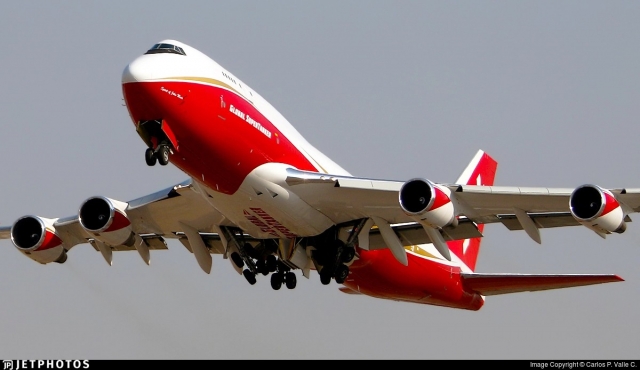Global Super Tanker Services (GSTS), an investor group that owns the Boeing 747 Supertanker N744ST, has this week taken the decision to cease their operations. Tanker 944 has been withdrawn from possible activities and shut down, as was announced to officials in Colorado, Oregon, Washington, and the federal government.
The concept of using a Boeing 747 airliner as firefighter was developed by the now defunct Evergreen airline. It was operationally used for the first time in 2009 in Supertanker N479EV (Tanker 979), which was based on a 747-100 originally manufactured by Boeing in 1971 for Delta Air Lines. After the demise of Evergreen, the retardant drop system of N479EV was used in a more modern Supertanker, N744ST, based on the commercial Boeing 747-400.
Already in 2009 some technical issues in the retardant drop system were identified such as retention of retardant in the system after drop, aeration of the retardant causing trail off, and inconsistent flight profiles affecting retardant coverage. Unfortunately nor Evergeen in its days, nor GSTS as its successor have been able to take care of the issues.
In the years that followed, the National Interagency Aviation Committee repeatedly issued an interim approval of the aircraft’s retardant delivery system. In 2020, an eighth interim approval was given to GSTS, with respect to the national situation regarding the Coronavirus (COVID-19). The approval lasted until 31 December of that year and N744ST spent several weeks in Moses Lake (WA), for routine maintenance and a conversion of the retardant delivery system from an analogue controller to a digital version.
That the curtain has now fallen over an aircraft that has just been configured and tuned with a new digital drop system and other upgrades to make it more safe and efficient, is both incomprehensible and disappointing!
In 2016 the 747 assisted firefighters in Israel, and in 2017 it spent several weeks working on fires in Chile. The air tanker also had an assignment in Mexico in 2011, and in 2019 spent about seven weeks on a firefighting contract in Bolivia.
GSTS is said to be in discussions with prospective buyers, but it is currently unknown if the aircraft will continue to be configured as an air tanker capable of carrying more than 17,500 gallons or if it would be used as a freighter.
Most large air tankers carry up to 3,000 gallons of retardant. The 747 is capable of carrying far more retardant than any other. When first introduced it was listed at 20,000 gallons. Then the federal government certified it at 19,200 gallons. More recently it was required to carry no more than 17,500 gallons. The second-largest capacity air tanker is the Russian-made Ilyushin IL-76 at 11,574 gallons. The DC-10 until a couple of years ago was allowed to hold 11,600 but federal officials now restrict it to 9,400.
Source: Fire Aviation
Photo: Carlos P. Valle C. (via Jetphotos)


